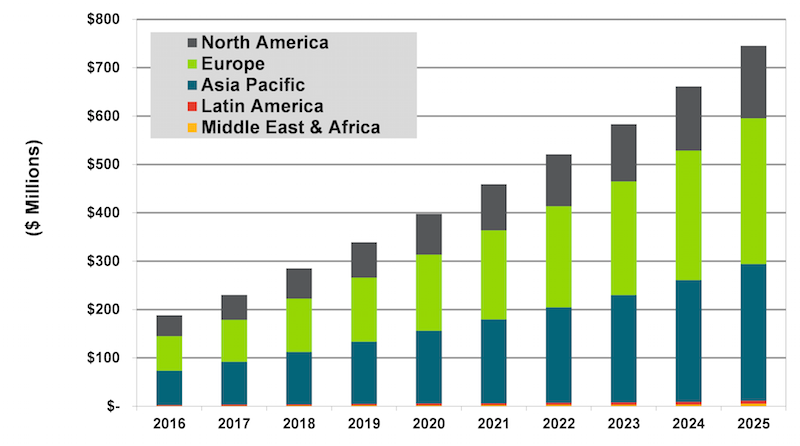Over the next decade, revenue from wireless sensor sales worldwide for installation and use in commercial structures is expected to increase at a compound annual rate of 16.5%, a projection that reflects the expanding demand for products that provide intelligent building solutions via the Internet of Things.
A new report from the market research firm Navigant, entitled “Wireless Sensors for Commercial Buildings,” estimates that global sensor sales will reach $188.2 million this year, and increase to $745.2 million by 2025.
“Sensors capture, communicate, and may even analyze energy and operational data,” the report states. “The resulting useful information will direct fundamental changes in operations that lead to energy efficiency improvements with substantial cost savings.”
Asia-Pacific and European markets are expected to experience the highest demand growth, whereas demand in North America will increase more modestly.
Despite the fact that last year’s Internet of Things World Forum was held in Dubai, the Middle East in general, along with Africa and Latin America, are not seen by Navigant as markets where there will be a high penetration of wireless sensors in the foreseeable future.
Related Stories
| Aug 11, 2010
'Flexible' building designed to physically respond to the environment
The ecoFLEX project, designed by a team from Shepley Bulfinch, has won a prestigious 2009 Unbuilt Architecture Design Award from the Boston Society of Architects. EcoFLEX features heat-sensitive assemblies composed of a series of bi-material strips. The assemblies’ form modulate with the temperature to create varying levels of shading and wind shielding, flexing when heated to block sunlight and contracting when cooled to allow breezes to pass through the screen.
| Aug 11, 2010
New book provides energy efficiency guidance for hotels
Recommendations on achieving 30% energy savings over minimum code requirements are contained in the newly published Advanced Energy Design Guide for Highway Lodging. The energy savings guidance for design of new hotels provides a first step toward achieving a net-zero-energy building.
| Aug 11, 2010
Section Eight Design wins 2009 Open Architecture Challenge for classroom design
Victor, Idaho-based Section Eight Design beat out seven other finalists to win the 2009 Open Architecture Challenge: Classroom, spearheaded by the Open Architecture Network. Section Eight partnered with Teton Valley Community School (TVCS) in Victor to design the classroom of the future. Currently based out of a remodeled house, students at Teton Valley Community School are now one step closer to getting a real classroom.







